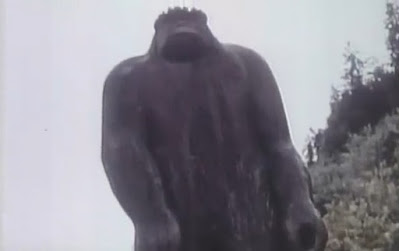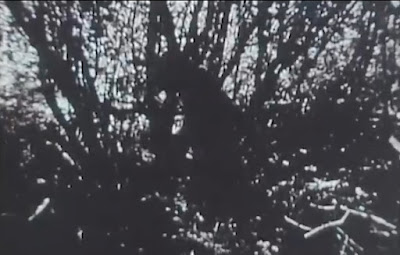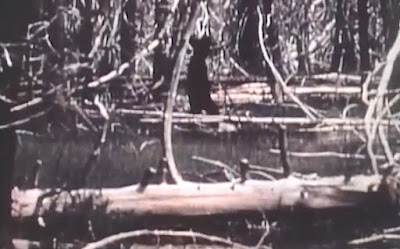Our film opens with the plaid-clad nature lover Ivan Marx swearing that what we are about to see is both true and authentic. And to prove this point, we're first entreated to several sequences of Marx tracking down and killing some renegade bears -- but only the guilty bears, mind you, not the innocent ones. (But I will point out most of the bears featured were not given proper due process).
Then he's off capturing a cougar for a zoo exhibit; and finally, a javelina is run down and hog-tied for some diabolical college experiment. Seriously, had some bad Catching Trouble (1936) flashbacks here, Fellow Programs, so brace yourselves as Ivan Marx is Ross Allen reincarnated.
Thus, with his rugged outdoorsman street-cred now firmly established, Marx is brought to Alaska to track down a rogue Kodiak that's been depleting the local cattle population. When Marx proves the bear was innocent (-- lucky bear), the rancher who hired him claims it never was a bear to begin with but a Bigfoot that was killing off his herd.
Now, a skeptical Marx had heard the legend of this creature before, dating back some 700 years, and the Native American tales of Stickmen and Oh-Man and Sasquatch, which is verified, somewhat, with some native etchings of a creature with big hands and massive clod-hoppers that, according to folklore, had a bad habit of raiding villages and stealing children.
Intrigued, but still unconvinced, Marx continues jumping around the country for various jobs; and with each successive stop, finds more and more evidence of this mysterious creature -- mostly foot and hand prints, and some coarse hair that he sends off for testing at some undisclosed lab.
These hair-test results are resulted before Marx goes out on his next job -- another guilty bear, I guess -- and the tests reveal that whatever left those prints and hair wasn't human; species unknown.
With his skepticism slowly devolving into apprehension, Marx finds the latest bear he'd been looking for already dead, its neck snapped, surrounded by some ginormous telltale footprints.
Convinced now that the creature really does exist, Marx sets out to separate fact from fiction; and come hell or high-water, he intends to capture the beast -- on film…
It was back in 1955, while hiking up Mica Mountain somewhere in the Rockies of British Columbia, when William Roe had an encounter with "a creature between six and seven feet tall that was hairy all over, had large breasts, a Negroid-shaped head, and walked on two legs."
This was the first widely reported North American sighting of a Sasquatch since the world became Yeti-addled when Sir Edmund Hillary brought tales of an Abominable Snowman back with him after he conquered Mount Everest in May, 1953.
The Grand Island Independent (October, 1967).
But it wasn't until about two years later, when several tracks of large, humanoid footprints were found in the soft loam along the logging trails around Bluff Creek, California, that the notion of Bigfoot was born.
And it was these very same tracks that later brought Roger Patterson and Bob Gimlin to the area in 1967, where they managed to capture what probably is the most infamous 16-seconds of footage ever committed to film; and with that footage, the legend of Bigfoot absolutely exploded into the national consciousness, creating a voracious appetite for more evidence that a lot of folks were happy to oblige with -- some more reputable than others.
The Kansas City Times (December 19, 1976).
Enter amateur filmmaker, naturalist, and self-proclaimed Bigfoot expert Ivan Marx.
"We tracked raccoons, mink, possum and skunk and sold their fur during the Depression," Marx told Jeanne Miller of the San Francisco Examiner (February 3, 1976). "When I got out of school I joined the Navy and spent the war years as a gunner's mate. Then I took my mustering out pay, bought myself some hound dogs, and set out for California, Mt. Shasta to be exact, and went into the tracking business because it was all I knew how to do."
The San Francisco Examiner (February 3, 1976).
Aside from taking care of those pesky animals, Marx also served as a game warden in Alaska for five years and later served as a guide for hunters and filmmakers.
Marx claimed his first encounter with a Bigfoot was back in 1951, when he found his first set of footprints around Dead Horse Summit in northern California. And he also claims to have snagged his first Bigfoot photos while hunting a cougar in Nevada in 1958 -- or maybe it was Washington?
"The first time I saw one was quite a shock," said Marx (The Kansas City Times, December 19, 1975), who apparently can't keep his stories straight. "I was in Washington on an assignment to get some shots of brown bear. It was about 5am and I was setting up my camera down by a waterhole where the bears liked to come every morning."
At first, Marx thought it was just another bear. "But when I got a good look at it, I knew it was no bear. It was 8-feet tall and very skinny. It had chocolate brown hair all over its body -- even its face and eyebrows." And as it turns out, Bigfoot were a little camera shy.
"When I turned on the camera, the noise made it stop. It looked right up at me, shrieked, and then lumbered off. It stopped once, turned around, and shrieked again and then disappeared into the brush."
As of 1976, Marx claimed to have had seven close encounters with the creatures. Like most people, at first, Marx didn't believe in Bigfoot. "As a professional hunter, tracker and trapper, I thought I had seen just about every kind of critter in the woods." Close, but not quite.
Now, it was about the same time the Patterson footage was making waves when Marx found the dubious Bossburg Prints in 1968, which showed an "arthritic deformity," giving them an air of authenticity.
Then in 1973, Marx received a call from a train engineer, who claimed that his engine had clipped one of the creatures in the same area east of Bossburg, Washington, near the Canadian border. All of this depends on which version you hear as other accounts say a man in a pickup hit the creature.
Look! IT'S BIGFOOT!!!
Either way, it wasn't a fatal collision and the creature crawled away. Here, Marx got the general location, found a blood trail, and with his wife, Peggy, tracked the injured beast for several days until they finally overtook the crippled creature and managed to not only get the encounter caught on film, but also managed to snap off several still-pictures before it limped off into the trees and disappeared.
It was this footage, and several more alleged encounters that Marx filmed in Alaska, that formed the backbone for The Legend of Bigfoot (1975).
Coming on the heels of Charles B. Pierce's highly profitable The Legend of Boggy Creek (1972), a tale of a bayou Bigfoot that terrorized the folks around Fouke, Arkansas, producer Marx and director Harry Winer used that film as a template, splicing together about two decades worth of nature stock, punctuated with a smattering of "authentic" Bigfoot footage to give it some pop.
"I don't know how dangerous a full grown Bigfoot might be if you were trying to capture it," said Marx (Miller, 1976). "I have no desire to harm the creatures. I only want to communicate with them, as I've been able to do with other animals."
But one thing Marx knew for sure, "Bigfoot tracks are unlike any other animal known to man, and those creatures we saw are unlike anything else I have ever seen."
According to the film, the search to get to this footage was a long and arduous one, with several false leads, hoaxes, and tantalizing glimpses to keep trailing narrator Marx -- and us -- along for the ride.
But then suddenly, Marx finds some deformed footprints, and while tracking them, catches up with what left them!
And here, finally, we get to see some clear footage of Marx's Bigfoot -- that I assumed was footage of the creature hit by that train; but here, Marx claimed that it has polio. (Because, sure.)
Claiming this footage was confirmed to be authentic by several experts, Marx scoffs at the detractors and searches for more evidence to prove these doubters wrong. And that's basically how the rest of the film plays out, with Marx gone Melville, looking for his personal white whale.
And as a viewer, as we watch Marx spout off some cock-eyed theories about Bigfoot migratory patterns, you have to wonder if our expert hasn't been out in the woods a little too long and is starting to get a little barmy in the old brain-pan.
As evidence, your honors, take a look at that whole, and embarrassingly long, law of nature sequence, where Marx uses a mortally wounded squirrel, stalked by an ever-circling chicken hawk, to illustrate that survival is the only law a Bigfoot has to abide by. (That's me shrugging right now.)
Next, things continue to unravel with another visit to Alaska to see Yukon Frieda and her gallery of Bigfoot paintings at the Sourdough Inn, where Marx gets a tip that the local Indians have a legend about "a friend" who returns all who die out on the frozen tundra to be buried with their own kind.
When Marx asks them where he can find this friend, the natives say to look for him in The Land of Shining Eyes. (Isn't that near Skagway?) But before he embarks, Marx is taught a Native ritual song to be sung during the next full moon that will guarantee a sighting of the glowing eyes of Bigfoot.
However, this proves too goofy, even for Marx, who refuses to play along and sets up a perimeter of walkie-talkies instead; but after several days pass with no sighting, he rounds up the radios, breaks out the old tom-tom, and whacks away.
Sure enough, lured by this siren call, something flashes its high-beams over a nearby hill -- and with that sequence, we've quickly taken a long walk off a terminally-short credulity pier.
Even with all of these sightings, Marx still has no solid proof of Bigfoot's existence. And as our nature-boy gives into despair, he goes out for one final look before chucking it in ... and just happens to stumble upon not one, but two, Bigfoot splashing around in a nearby creek!
Watching these creatures at play, Marx seems to come to terms with the fact that he may never have all of the answers to his questions about Bigfoot.
Content in the fact that he no longer cares about such questions, he will instead bask in the sheer wonderment of these mysterious creatures, which brings us mercifully to the end of this quackery.
Often confused with the similarly themed and exponentially better Sasquatch: The Legend of Bigfoot (1976), in which another expedition of experts head off into the wilderness to track down some rock-chucking Sasquatch, The Legend of Bigfoot is fairly effective as a nature documentary.
Sure, it's probably a tad too long, and too repetitive in spots, but Marx has a real eye for the scenery. He isn't shy about getting up close and personal with the animals, and captures some wonderful bear footage of bears doing what bears do in the wild and a spectacular sequence of some rutting moose.
There's also some amazing footage of the northern lights that must've really been something before the print degenerated to the point where I watched it.
And Marx comes off as a rather affable -- okay, sometimes irascible -- narrator, who loves the Inuit people and seethes at the encroaching signs of civilization that will soon make his beloved wilderness and all of its denizens extinct.
The Leader Telegram (February 13, 1976).
It's just too bad that all of his "actual" Bigfoot footage, which is set-up brilliantly, allowing it to creep up on us through the trees, is about as convincing as a three dollar bill when the camera steadies and the creature comes into focus.
Yeah, big surprise, it's all bullshit.
The Daily World (January 2, 1976).
"The Legend of Bigfoot is a draggy, bloated attempt to turn a dollar or two off of the legend of the elusive monster which some folks say lives in the Pacific coastline of North America," said Bob Woessner of the Green Bay Press-Gazzette (February 26, 1976). "The film sloshes around for an hour and a half before Marx unveils what he says is film of a Bigfoot, or Bigfeet. But let's not keep trying to con folks. If someone has real film of such creatures let them show us, and hopefully, show us better than Marx did."
Winston
Cavin of the Winston-Salem Sentinel agreed, saying (January 19, 1976),
"Backed by a nationwide monster fascination and flamboyant local
promotion, The Legend of Bigfoot is a rip-off if you believe the
advertisements trumpeting it as documentary proof of the Giant of the
North's existence. All you see are brief, blurry shots of a beast
shrouded in indirect light and surrounded by shadows. And, of course,
no closeups. And despite Marx's claim that his evidence is
unchallengable, there is no real proof offered."
The Albuquerque Journal (November 5, 1975).
In rebuttal, Marx told Miller there was a reason he couldn't get better shots of the elusive creatures. "I didn't dare go any closer than I did because every animal has a pressure point and I didn't know what theirs is. For a cougar, it's seven feet. For a bear, 25 feet. Any closer and you're dead if you're not an expert hunter."
Wait. But wasn't he an expert hunter?
Rumors abound that the Marxes bought a bunch of fur coats at a second-hand store right before his first Bigfoot pictures started to surface. Also, the fact that when the location of the footage is checked for scale, the creature wasn't seven to eight feet tall as Marx claimed, but about the same height as his wife, Peggy. And one can't help but note that Marx probably could only afford to do one suit, as the two Bigfoot at Beaver Swamp are never in the same frame together during the climax, which feels a little dubious to me.
But all the disparaging comments and increasingly bad rep in the Bigfoot community didn't seem to matter as Marx became sort of a Bigfoot media celebrity, going out on a barnstorming lecture tour to promote the film, or appearing on several TV shows -- one where they developed some raw footage and screened it for the audience, which showed an albino Bigfoot frolicking in the snow. And a lot of his footage showed up in the Rod Serling narrated Monsters! Mysteries or Myths? (1974).
The Los Angeles Times (November 25, 1974).
And then there's this, here, full-length feature documentary, made to feed the Bigfoot-mania sweeping the country in the late 1970s. I was proud to be a part of that back then. And there's still a part of my brain that houses an irrational fear of this creature that surfaces and taps me on the shoulder and says, "Booga-booga!", whenever I watch any of these old mockumentaries; and frankly, they still tend to creep me out a bit.
They don't call it irrational for nothing, Fellow Programs. Calm down.
But as time passed, more and more of Marx's photos, footage, and findings were called into question and exposed as fakes (-- like the ones above.) And his follow up documentary, In the Shadow of Bigfoot (1977), is so faked its not even funny. Even his most staunchest defenders claimed most of his evidence was probably staged; and now, these days, with his reputation in tatters, Marx is usually singled out as the worst huckster to ever huck a hoax and is blamed for setting the science of cryptozoology back several decades with his shenanigans.
And yet, he wasn't alone. In fact, it's been a dark period for Bigfoot enthusiasts. Those Bluff Creek footprints found back in the '50s that started all the initial hysteria? Well, they turned out to be fakes, too. The hoax was revealed with the death of Ray Wallace in 2002; after which, in accordance with his final wishes, Wallace's family came forward with the molds and rubber casts used to make all of the fake prints.
And if we follow the fruit of this poisoned tree, that probably means the much contested Patterson footage, shot in the same area, and corroborated by several footprints that bear a striking similarity to Wallace's forgeries, is cast into even further doubt.
Do I believe in Bigfoot? Well, I like to believe in the idea of Bigfoot; and lake monsters; and the Bermuda Triangle; and UFOs. I like the idea that there's still some stuff out there that we can't explain just yet. And maybe, just maybe, there’s a North American primate that hasn’t been cataloged yet either. Maybe.
Originally Posted on October 30, 2007, at 3B Theater.
The Legend of Bigfoot (1976) Palladium Productions / EP: Ivan Marx, Don Reese / P: Stephen Houston Smith / D: Harry Winer / W: Harry Winer, Paula Labrot / C: Ivan Marx, Peggy Marx / E: Paula Labrot / M: Don Peake / S: Ivan Marx, Peggy Marx





















%201973.jpg)





























No comments:
Post a Comment